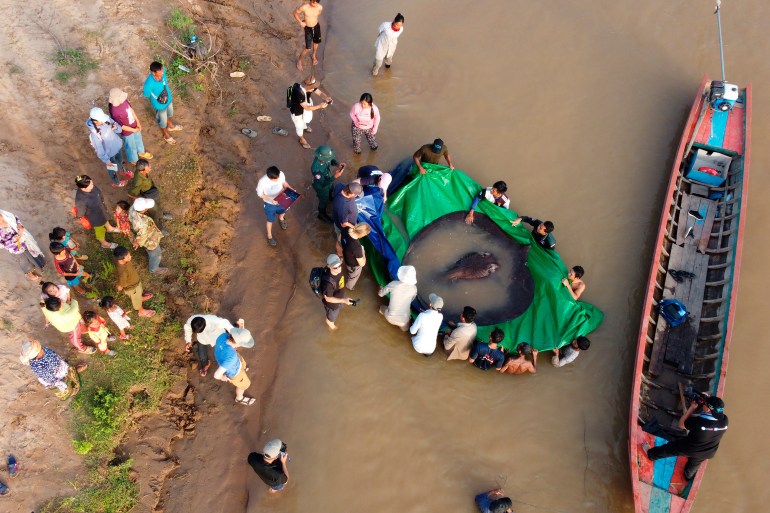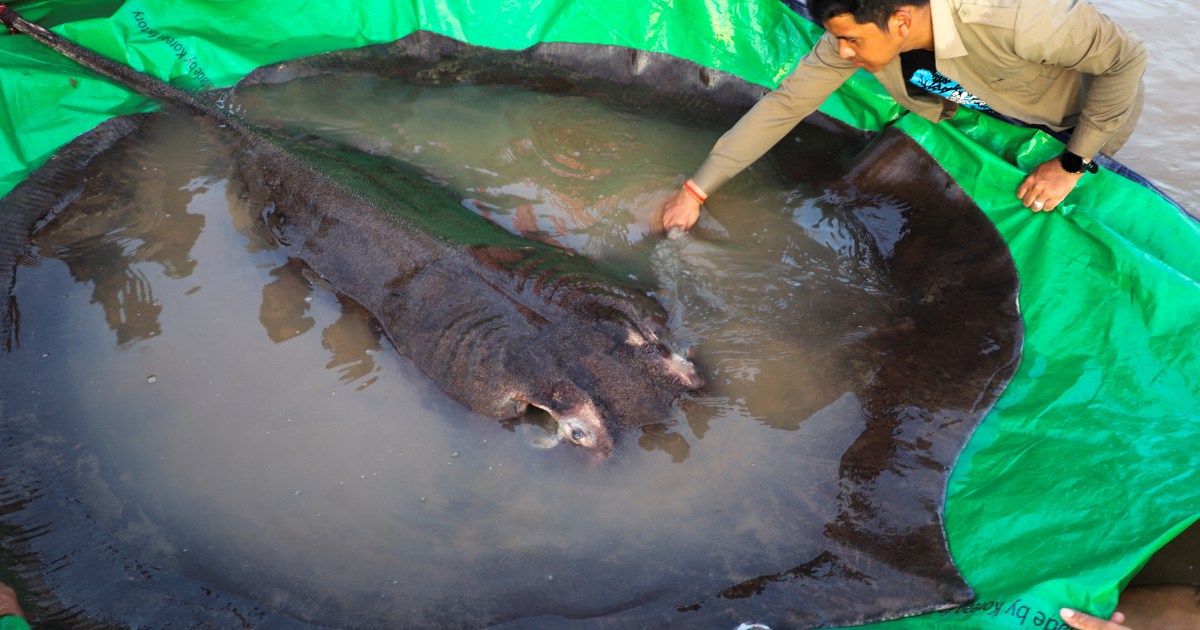World’s largest freshwater fish caught in Cambodia
Fisher on the Mekong River caught a giant stingray that weighed almost 300kg.
A fisher in Cambodia has caught what scientists say is the world’s largest recorded freshwater fish, a giant stingray.
Captured on June 13, the stingray measured almost four metres (13 feet) from snout to tail and weighed slightly less than 300kg (660lbs), according to a statement on Monday by Wonders of the Mekong, a joint Cambodian-US research project.
The previous record for a freshwater fish was a 293-kg (646-lb) Mekong giant catfish, discovered in Thailand in 2005, the group said.
Christened “Boramy”- meaning the full moon in the Khmer language – because of her bulbous shape, the stingray was caught south of Stung Treng on the Mekong River in northeastern Cambodia. It took about a dozen men to haul the fish ashore.
They alerted a nearby team of scientists from the Wonders of the Mekong project, which has publicised its conservation work in communities along the river.
The scientists arrived within hours of getting a post-midnight call with the news, and were amazed at what they saw.
“When you see a fish this size, especially in freshwater, it is hard to comprehend, so I think all of our team was stunned,” Wonders of the Mekong leader Zeb Hogan said in an online interview from the University of Nevada in Reno.

Freshwater fish are defined as those that spend their entire lives in freshwater, as opposed to giant marine species such as bluefin tuna and marlin, or fish that migrate between fresh and saltwater like beluga sturgeon.
The discovery of the stingray was not just about setting a new record.
“The fact that the fish can still get this big is a hopeful sign for the Mekong River, ” Hogan said, noting that the waterway faces many environmental challenges.
The Mekong River runs through China, Myanmar, Laos, Thailand, Cambodia and Vietnam. It is home to several species of giant freshwater fish but environmental pressures are rising. In particular, scientists fear a major programme of dam building in recent years may be seriously disrupting spawning grounds.
“Big fish globally are endangered. They’re high-value species. They take a long time to mature. So if they’re fished before they mature, they don’t have a chance to reproduce,” Hogan said. “A lot of these big fish are migratory, so they need large areas to survive. They’re impacted by things like habitat fragmentation from dams, obviously impacted by overfishing. So about 70 percent of giant freshwater fish globally are threatened with extinction, and all of the Mekong species.”
The team that rushed to the site inserted a tagging device near the stingray’s tail before releasing it. The device will send tracking information for the next year, providing unprecedented data on its behaviour.
“The giant stingray is a very poorly understood fish. Its name, even its scientific name, has changed several times in the last 20 years,” Hogan said. “It’s found throughout Southeast Asia, but we have almost no information about it. We don’t know about its life history. We don’t know about its ecology, about its migration patterns.”
Researchers say it is the fourth giant stingray reported in the same area in the past two months, all of them females. They think this may be a spawning hotspot for the species.
The fisher who caught Boramy, in addition to the honour of having caught the record-breaker, was compensated at the market rate, meaning he received a payment of about $600.




